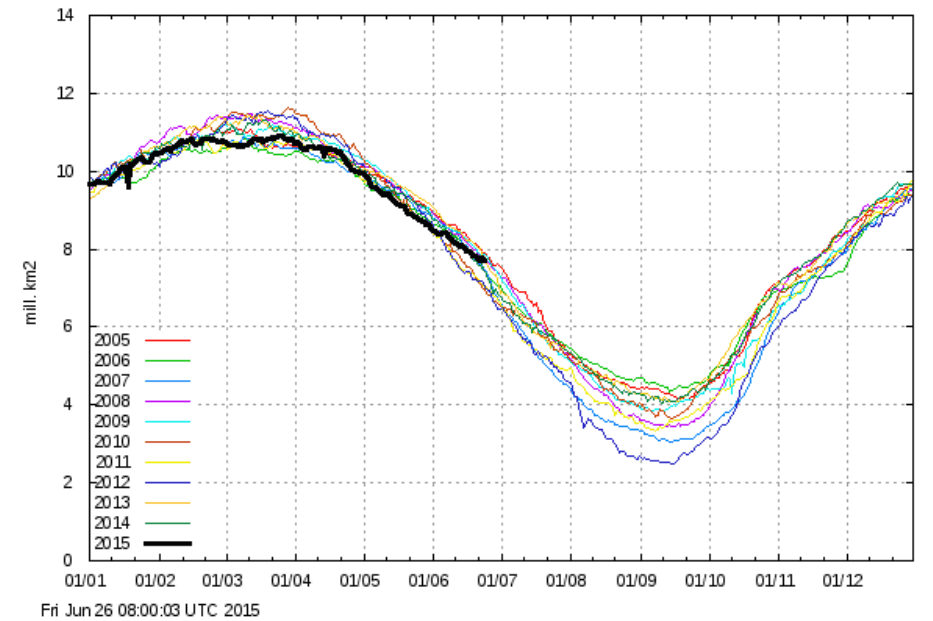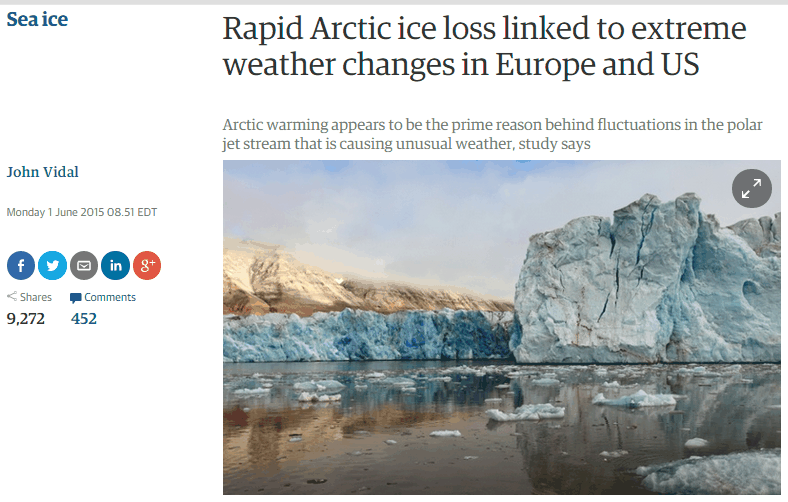As climate experts ramp up their lies about Arctic sea ice, extent is the highest for the date since 2005, and melt is the slowest since at least 2004.
If this weather forecast showing sub-freezing temperatures in the Beaufort Sea is correct, alarmists are in a world of hurt.
Greenland’s surface has gained over 500 billion tons of ice since September
The criminals at the Guardian are of course lying to their readers about this, as they do nearly 100% of the time.






Non-existent rapid ice loss has contibuted to non-existent extreme weather changes in Europe and the US, except for the two last extremely cold winters in the US.
I live, unfortunately, in the Ozarks of north-western Arkansas … last winter we had several bouts of temps dropping into the minus 15 degrees fahrenheit range ( -15 degrees F) which lasted for days at a time … I have a solar battery bank in a shed that I was very worried would freeze up, and that’s why I pay particular attention to the temperature.
The winter before last was almost as cold … yet the normal average temps for Arkansas are: http://arkansas.stateguidesusa.com/answers-to-my-questions/what-are-the-average-monthly-temperatures-in-arkansas?/ The global cool down has begun!!!!!
“Greenland’s surface has gained over 500 billion tons of ice since September . .”
But but but but . . the AP says: “Glaciers might move slowly, but they have their dramatic moments. Scientists tracking glacial earthquakes in Greenland have managed to crack open the mysterious dynamics of calving icebergs. The results, published in the journal Science, could help scientists track the loss of the Greenland Ice Sheet, which is shrinking even faster than Antarctica.”
Here: http://www.latimes.com/science/sciencenow/la-sci-sn-glacier-earthquake-iceberg-greenland-ice-20150625-story.html
From La La Land times, where sceptics are barred from commenting? Can you say propaganda?
Nothing but the best in propaganda.
La La Land Times has all those out of work Hokeywood script writers they can draft as ‘Journalists’ to bring the finest propaganda to the eyes of the progressives serfs still capable of reading.
Where’s Jim?
When the positive feedback factors go away, ice melt decelerates.
The current conditions are simply due to the accumulation of thick, lumpy, multiyear ice over the last couple years. The Beaufort Gyre region is filling up with MYI and the effect is being seen now, after the thin flat ice that melts quickly is gone. The thick ice formed by ridging reduces the melt pond areas to the valleys and the higher conductivity and higher melting temperature of the MYI lets it get thicker through the winter and resist melting through the spring. These positive feedback effects were trumpeted endlessly by the Global Warming Theorists when the wind blew the MYI out of the Arctic. Now that the winds are allowing the natural accumulation of the MYI in the Gyre the trend has reversed.
These Articles say the Arctic is still melting rapidly… when in fact… BOTH the Arctic and Greenland are GAINING ICE.. !!
Check out the comments on there .. that’s what we’re up against, a constant barrage of Warming Hype… lies…
When will these bozo’s realise that the current amount of Arctic sea ice is much HIGHER than it has been for most of the last 10,000 years…
Arctic sea ice levels are anomalously HIGH, not slightly low.
… and that we are only a tiny molehill out of the coldest, nastiest period in whole of the current interglacial.
There can’t be too much melting going on in Greenland at the moment. The air is quite dry; big gaps between temperature and dewpoint, eg BGUQ (Qaarsut) temp 16°C dewpoint -2°C
http://www.dmi.dk/en/groenland/vejret/metar-og-taf/
Reblogged this on Globalcooler's Weblog.
It’s the Grauniad.. what do you expect? They lost their sanity years ago
Note: Snow cover has not updated as of yet. Wonder what’s going on? But it’s obvious that the Arctic sea ice extent this year is greater than the same date last year.
http://igloo.atmos.uiuc.edu/cgi-bin/test/testimage.2.sh?first=20140626.jpg&second=20150626.jpg
Its the slow rate of melting that is interesting. Its a lot slower than previous years.
If it doesn’t speed up melting really soon, it will be within one sd of the 1981-2010 mean.
https://sunshinehours.files.wordpress.com/2015/06/arctic_sea_ice_extent_zoomed_2015_day_179_1981-2010.png
In QC we normally use 2 standard deviations ( ? ) from the mean. You do not touch a process as long as it is within two to two and a half ? since statistically the value is no different than the mean. The easiest way to muck-up a process is to adjust when the process is just varying within the typical distribution. Statistical Process Control (SPC): Introduction and Background
https://www.mathsisfun.com/data/images/normal-distrubution-3sds.gif
Too bad ClimAstrologists are deficient in math skills or they would know this elementary stuff that I routinely taught to production workers.
Try again: Note: Snow cover has not updated as of yet. Wonder what’s going on? But it’s obvious that the Arctic sea ice extent this year is greater than the same date last year. If the Jpg fails I have included a link.
http://igloo.atmos.uiuc.edu/cgi-bin/test/testimage.2.sh?first=20130626.jpg&second=20150626.jpg
http://igloo.atmos.uiuc.edu/cgi-bin/test/print.sh?fm=06&fd=26&fy=2013&sm=06&sd=26&sy=2015
A little OT but interesting Nat Geo article on photographing the midnight sun:
When the Sun Burns a Hole in Your Photo
http://proof.nationalgeographic.com/2015/06/18/when-the-sun-burns-a-hole-in-your-photo/?utm_source=NatGeocom&utm_medium=Email&utm_content=pom_20150628&utm_campaign=Content
The same graph shows January, March and May as each having the lowest ice extent in a decade. Strange that this doesn’t get a mention.
You need glasses. May is lower, but not January or March. And besides, that is not the topic of this thread. Are you some kind of doomer?
It did at the time.. It is now June. (Did you know that ?)
And look how slowly its decreasing compared to previous years.
If you are so worried about what “did” happen, why not compare to the first 9000 years of the current interglacial called the Holocene.
Biological markers in sediments show that Arctic sea ice levels were much lower, even described as “seasonal ice’. ie winter only. They even have a term for the “NEOGLACIATION” that started some 2000-3500 years ago
The Arctic sea ice level is actually ANOMALOUSLY HIGH compared to all the last 10,000 years, bar the LIA, which the temperature is only just a small amount above. Northern Russian port which were once fishing villages, are now iced in for most if not all of the year.
There is absolutely NOTHING untoward or unusual about the current levels of summer Arctic sea ice.
https://edmhdotme.files.wordpress.com/2015/05/screen-shot-2015-05-25-at-11-09-40.png
AndyG55 says: “….There is absolutely NOTHING untoward or unusual about the current levels of summer Arctic sea ice.”
Well yes there is. Ice has been increasing indicating the long term CLIMATE is cooling not warming.
Ice free Arctic Ocean, an Early Holocene analogue
Temperature and precipitation history of the Arctic
A new approach for reconstructing glacier variability based on lake sediments recording input from more than one glacier January 2012
VALIDATION BY ALTERNATE STUDIES
Mid to late Holocene sea-level reconstruction of Southeast Vietnam using beachrock and beach-ridge deposits
Translation the sea level was up to 1.5 meters higher than today in a tectonically stable area ~5000 years ago to 2000 years ago. And half way around the world in another tectonically stable area we find the same thing.
Late Quaternary highstand deposits of the southern Arabian Gulf: a record of sea-level and climate change
This study shows a sea level highstand ~1 to 2 meters above the present level about ~5500 years ago.
THIRD METHOD OF VALIDATION
Sea Level Changes Past Records and Future Expectations
Yeah, I didn’t phrase that very well, did I. Me bad.
I did mention that the Arctic sea ice level is anomalously HIGH compared to the rest of the Holcene…so I suppose that makes it untoward and unusual.
ps I was reading a paper somewhere about sediments from Fram Straight. (darned if I can find the link)
After a mostly Ice-free Arctic for the first 2/3 of the Holocene, Neoglaciation was clearly evident in the biological strata, starting around 3500 years ago.
Was warm once, but has been cooling sinc about 3500 years ago except for a couple of minor bumps around the times of the RWP and MWP, and the very tiny bump of the MSWP, (Modern Slightly Warm Period).
Should we tell him that tomorrow is July, or let him try and figure that out on his own?
Hey, he’ll catch up eventually …. maybe.